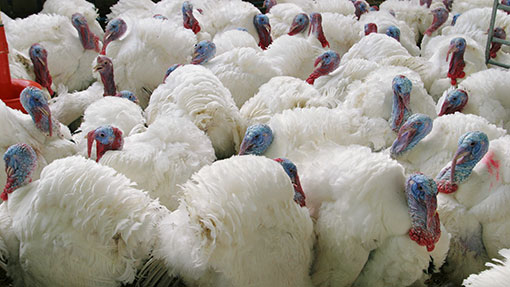Top tips for successful turkey production

Turkey production is a popular diversification for mixed farms. Read our guide and case studies into seasonal turkey farming and marketing birds from some of the UK’s most successful producers.
Rearing free-range turkeys for the Christmas trade is becoming increasingly popular among farmers looking for diversification enterprises.
But while there still appear to be plenty of opportunities for newcomers keen to meet the seasonal demand, embarking upon such a venture is still heavily dependent upon effective marketing as much as mastering rearing and management techniques.
Yorkshire turkey producers Tim and Lynne Lindley from Dewsbury produce around 2500 free-range birds a year and advise anyone considering rearing turkeys for Christmas to first make sure they have a market for their birds.
“Rearing turkeys requires good levels of stock management and commitment throughout the lifetime of the birds, but no matter how good you are at the job – or think you could be – it’s no good having a field full of top-quality birds at the beginning of December with no one to buy them.”
Award-winning turkey producer Paul Kelly of Kelly Bronze Turkeys, Danbury, Essex, who provides franchise opportunities for farmers wanting to rear turkeys, agrees that marketing is at the top of the list for newcomers. But prospective rearers must also make sure they can provide a high standard of stock management.
“Turkeys can be difficult to brood. It’s the first part of the rearing stage and it’s the most critical,” he says.
“Many first-timers get too many chicks for the size of the brooder. It’s vital to make sure the brooder is the correct size to cope with the number of chicks you’ve ordered; all too often there can be heavy losses because the brooder isn’t big enough and chicks have suffocated trying to huddle underneath the heat.
“Temperature in the brooder is also very important in the early stages – too hot and chicks will move out and away from the brooder and become stressed, while if it’s too cold they will congregate underneath, crowd together and losses will result.”
The ideal temperature is a steady 37C under the brooder, and 15-18C outside.
Kelly Bronze Turkeys, which provides detailed rearing advice for new starters to turkey rearing, stresses that “TLC” is essential to produce healthy well-grown turkeys.
“There are tricky stages in the rearing process, but provided high standards and regular monitoring are maintained, the chicks will thrive. If you do a good job, poults could be off-heat within three weeks.”
There are precise EU stocking densities and space requirements prescribed for turkey rearing. For free-range systems, a one acre field can accommodate 1000 birds, but the land must be well-drained. “You certainly don’t want turkeys paddling about in wet conditions in the months running up to Christmas,” says Mr Kelly.
Electric fencing is essential to contain the birds and prevent access to the range by predators. And it’s important to make sure areas used each year for rearing are treated annually with lime, to avoid the build-up of parasites.
One of the most important jobs of the day during the turkey rearing season is to ensure the birds are safely inside their housing at night – and in autumn and early winter that can mean birds moving inside in late afternoon.
“Switching on a light in the sheds as dusk starts to fall will entice the birds towards the light and help to move them inside. A low light can be left on in the shed all night to prevent the birds panicking and the floor should be strawed with fresh material daily rather than allowed to become fouled and having to bed heavily once a week.”
But perhaps the most unusual tip Mr Kelly has for new starters to poultry rearing concerns yard lights.
“It’s very commonplace for farms to have yard security lights, but if they shine into the turkey shed the brightness will encourage female birds to start squatting and laying which must be avoided. It’s important that turkeys don’t have their day-length extended or they will move into breeding condition.”
